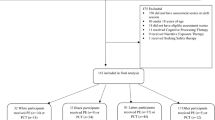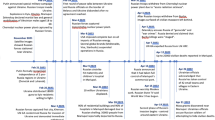Abstract
Racial/ethnic minority women in a disadvantaged urban neighborhood may experience a high rate of post-traumatic stress disorder (PTSD) and depression. This brief report examined the frequency of a PTSD diagnosis and subthreshold PTSD among 72 female participants with depressive symptoms in a mindfulness-based intervention for depression at an urban federally qualified health center (FQHC). The MINI International Neuropsychiatric Interview was used to assess PTSD diagnosis or subthreshold PTSD, and the Inventory of Depressive Symptomatology–Self-Report (IDS-SR) was used to assess depressive symptoms. We conducted a descriptive analysis of trauma experiences and explored the neighborhood context of the participants. Fifty-one percent of women self-reported that they experienced a traumatic event. Twenty-nine percent of women met PTSD diagnosis and 7% had subthreshold PTSD; women with a PTSD diagnosis or subthreshold PTSD had significantly worse depressive symptoms. Commonly reported traumas included witnessing a murder, experiencing abuse, and domestic violence. This brief report highlights the high frequency of PTSD diagnosis and subthreshold PTSD among underserved women with depressive symptoms. This may be associated with trauma events linked to residing in a disadvantaged neighborhood.
Similar content being viewed by others
References
Hill TD, Ross CE, Angel RJ. Neighborhood disorder, psychophysiological distress, and health. J Health Soc Behav. 2005;46(2):170–86.
Krivo LJ, Peterson RD. Extremely disadvantaged neighborhoods and urban crime. Social Forces. 1996;75(2):619–48.
Giurgescu C et al. The impact of neighborhood quality, perceived stress, and social support on depressive symptoms during pregnancy in African American women. Soc Sci Med. 2015;130:172–80.
Gapen M et al. Perceived neighborhood disorder, community cohesion, and PTSD symptoms among low-income African Americans in an urban health setting. Am J Orthopsychiatry. 2011;81(1):31–7.
Teychenne M, Ball K, Salmon J. Physical activity, sedentary behavior and depression among disadvantaged women. Health Educ Res. 2010;25(4):632–44.
Belle D, Doucet J. Poverty, inequality, and discrimination as sources of depression among US women. Psychol Women Q. 2003;27(2):101–13.
Gill JM et al. Experiences of traumatic events and associations with PTSD and depression development in urban health care-seeking women. J Urban Health. 2008;85(5):693–706.
PTSD: National Center for PTSD, in Women, Trauma, and PTSD. 2015;U.S. Department of Veterans Affairs.
Carr ER et al. PTSD, depressive symptoms, and suicidal ideation in African American women: a mediated model. J Clin Psychol Med Settings. 2013;20(1):37–45.
Powers A et al. Associations between childhood abuse, posttraumatic stress disorder, and implicit emotion regulation deficits: evidence from a low-income. Inner-City Population Psychiatry. 2015;78(3):251–64.
Lowe SRQ, Quinn JW, Richards CA, Pothen J, Rundle A, Galea S, Ressler KJ, Koenen KC, Bradley B. Childhood trauma and neighborhood-level crime interact in predicting adult posttraumatic stress and major depression symptoms. Child Abuse Negl. 2016;51:212–22.
Seedat S et al. Disability and quality of life in post-traumatic stress disorder: impact of drug treatment. PharmacoEconomics. 2006;24(10):989–98.
Franklin CL et al. Defining subthreshold PTSD in the DSM-IV literature: a look toward DSM-5. J Nerv Ment Dis. 2015;203(8):574–7.
Mylle J, Maes M. Partial posttraumatic stress disorder revisited. J Affect Disord. 2004;78(1):37–48.
Brancu M et al. Subthreshold posttraumatic stress disorder: a meta-analytic review of DSM-IV prevalence and a proposed DSM-5 approach to measurement. Psychol Trauma. 2016;8(2):222–32.
Rush AJ, Carmody T, Reimitz PE. The inventory of depressive Sypmtomatology (IDS): clinician (IDS-C) and self-report (IDS-SR) ratings of depressive symptoms. Int J Methods Psychiatr Res. 2000;9:45–59.
Rush AJ et al. The 16-item quick inventory of depressive symptomatology (QIDS), clinician rating (QIDS-C), and self-report (QIDS-SR): a psychometric evaluation in patients with chronic major depression. Biol Psychiatry. 2003;54(5):573–83.
Association, A.P Diagnostic and statistical manual of mental disorders (DSM-IV-TR). 4 ed. 2000, Washington DC.
Race and Ethnicity by Neighborhood in Chicago. 2016 [cited 2016; Available from: http://statisticalatlas.com/neighborhood/Illinois/Chicago/Uptown/Race-and-Ethnicity.
Oakland neighborhood in Chicago, Illinois (IL), 60653 detailed profile 2016 [cited 2016 0209]; Available from: http://www.city-data.com/neighborhood/Oakland-Chicago-IL.html.
Crime in Chicago. CRIME TRENDS IN OAKLAND 2016 [cited 2016; Available from: http://crime.chicagotribune.com/chicago/community/oakland.
Kennedy AC, Bybee D, Greeson MR. Examining cumulative victimization, community violence exposure, and stigma as contributors to PTSD symptoms among high-risk young women. Am J Orthopsychiatry. 2014;84(3):284–94.
Walsh K et al. Prevalence of sexual violence and posttraumatic stress disorder in an urban African-American population. J Immigr Minor Health. 2014;16(6):1307–10.
Alcantara C, Casement MD, Lewis-Fernandez R. Conditional risk for PTSD among Latinos: a systematic review of racial/ethnic differences and sociocultural explanations. Clin Psychol Rev. 2013;33(1):107–19.
Ford JD. Ethnoracial minority background, psychological trauma, PTSD and DESNOS among urban low-income women with severe mental illness. Journal of Psychological Trauma. 2008;7(3):170–84.
Ford JD. Ethnoracial and educational differences in victimization history, trauma-related symptoms, and coping style. Psychological Trauma-Theory Research Practice and Policy. 2012;4(2):177–85.
Acknowledgements
The authors would like to acknowledge the contributions of the patients and staff at the Near North Health Centers and the Agency for Healthcare Research and Quality K12 for funding that supported this work (AHRQ K12HS023011).
Author information
Authors and Affiliations
Corresponding author
Ethics declarations
Funding
This study was funded by the Agency for Healthcare Research and Quality under K12.
Conflict of Interest
The authors declare that they have no conflict of interest.
All procedures performed in studies involving human participants were in accordance with the ethical standards of the institutional and/or national research committee and with the 1964 Helsinki declaration and its later amendments or comparable ethical standards. Informed consent was obtained from all individual participants included in the study.
Rights and permissions
About this article
Cite this article
Hong, S., Burnett-Zeigler, I. The Frequency of PTSD and Subthreshold PTSD among African–American Women with Depressive Symptoms in a Disadvantaged Urban Neighborhood: Pilot Study. J. Racial and Ethnic Health Disparities 4, 1069–1073 (2017). https://doi.org/10.1007/s40615-016-0311-3
Received:
Revised:
Accepted:
Published:
Issue Date:
DOI: https://doi.org/10.1007/s40615-016-0311-3




